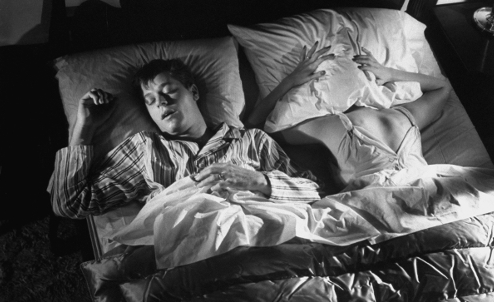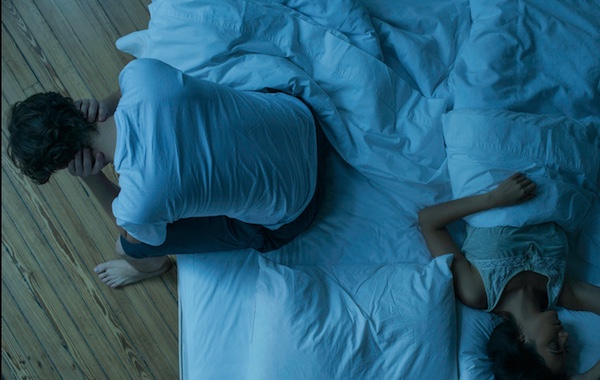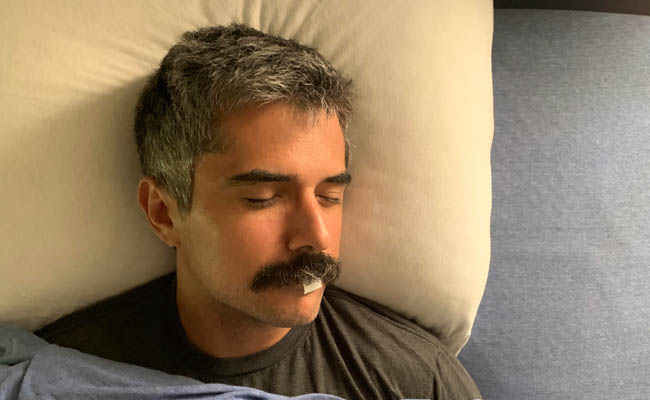
Last week we discussed the nature of sleep and why it’s so important that you get enough of it.
If you’ve had trouble falling asleep for years, the information may have made you feel more frustrated than inspired. Fear not! Today we’ll take a look at a wide range of tips for slumbering soundly, night after night.
If you’ve been getting okay sleep, my goal is that you’ll find a tip that can help you make it much better.
Before we begin, the important thing to understand is that getting a good night’s sleep is an all-day affair. How you wake up, what you do during the day, and your nightly routine can all affect the quality and quantity of your sleep. Below are some research-backed tips that you can employ from dawn to dusk to prepare your body and mind for sleep. Make sure to experiment; what works for someone else might not work for you. You might consider investing in a sleep tracker or downloading a sleep-tracking app so you can measure the effects of your sleep experimentation.
Preparing For Good Sleep
1. Invest in a good mattress. Remember, you’ll spend an average of 24 years – 24 years! – of your life sleeping. So there’s no investment that yields a better ROI than a mattress that helps you slumber soundly (and that’s not always the most expensive one, either). Pick the mattress that’s right for you. If the manufacturer lets you test it out for a trial period, all the better.
While you’re at it, change your sheets once a week. Nothing feels better than getting into a bed with nice, clean linen.
2. Find your ideal sleeping schedule by going camping for a week. If you want to find the ideal amount of sleep your unique body craves, as well as its ideal wake time, go camping for a week. Researchers at the University of Colorado found that participants who roughed it in the great outdoors shifted their sleeping schedule to one that lined up more with the earth’s natural solar day and night. In the absence of artificial light, they returned to their primeval pattern. On average, the participants went to bed earlier, woke up earlier, and slept longer. Even self-proclaimed night owls shifted to a sleep/wake cycle that lined up with the natural solar day and night and started going to sleep well before their “normal” bedtime back home. (This suggests that their night owl-ness may be driven more by preference and habit than their biological makeup.)
Even if your “real life” schedule can’t accommodate the natural sleeping schedule you uncover while slumbering in the wild, it can provide you ideals to shoot for. And the experiment should at least give you an idea of how much sleep your body needs to feel fully rested. Shoot for that number, whatever your schedule may be.
And if you’re suffering massive sleep debt, a week of camping away from artificial light and the stresses of modern life is a great way to catch up on some much-needed Zs.
Be sure to listen to our podcast on how to get a better night’s sleep:
When You Wake Up and During the Day
3. Stick to a consistent schedule. Our bodies are evolved to sleep at a regular schedule. Ideally, that schedule would align with the earth’s natural day and night cycle. In our modern 24/7 society, that sort of schedule is not possible for most of us. But we can do our best to be consistent with the sleep schedule that we do have. Experiment, find the schedule that works for you, and then stick to it like clockwork — that means going to bed and waking up at the same time every day – even on weekends!
4. Wake up at the same time every morning. If for any reason you have to go to bed later than usual, try to still wake up at the same time. This is particularly important if you’re trying to establish a new, healthier sleep schedule. The time of your waking seems to set the schedule of when you’ll start feeling sleepy later in the day. Thus, if you go to bed late, and then wake up late, it’ll start a cycle that messes up your whole rhythm. If you instead get up early even after going to bed late, you’re more likely to feel tired at the desired time.
5. Never hit the snooze button. In hitting the snooze button you may think you’re giving your body and mind the bit of extra sleep that it needs, but you’re actually just setting yourself up to feel groggier than you would have if you’d just gotten right out of bed. You see, when you hit snooze and drift back to sleep, rather than returning to the lighter sleep stage you were just in (in which your body may have already been preparing to wake up), you may begin a new sleep cycle altogether. Then, when the alarm goes off the second time, it’ll likely catch you in a deeper stage of sleep, leaving you feeling groggy, ill-rested, and looking for a mallet to smash your alarm clock. To help rid yourself of this habit, try placing your alarm (be it a phone or a clock) in a place where you’ll have to physically get out of bed to turn it off.
6. Expose yourself to bright light as soon as you get up. Bright light, particularly blue light, sends a signal to our brain to stop releasing melatonin and to start raising cortisol levels to help wake us up. Research suggests that morning exposure to bright light not only helps wake you up, but can also help you get to sleep later that night. Early morning light may even help regulate your metabolism; one study showed a correlation between exposure to light in the morning and a healthy BMI. The author of that study, Dr. Phyllis C. Zee, explains: “Light is the most potent agent to synchronize your internal body clock that regulates circadian rhythms, which in turn also regulates energy balance. The message is that you should get more bright light between 8 a.m. and noon.”
If you wake up after the sun rises, take a 20-minute walk in the morning to let your eyes bask in its dawning rays. But exposure to bright light is particularly helpful if you rise when it’s still dark. In such a case, you’ll have to bring in an artificial source of light. One thing that I’ve had a lot of success with is Philips goLITE BLU. I turn it on and sit in front of it for 20 minutes while I’m doing my morning routine.
While the blue light emitted from your electronic devices isn’t as strong, taking a look at your laptop as soon as you get out of bed can help wake you up too; however, checking your email first thing in the morning can also induce crankiness and doesn’t get your morning off to the right, focused start.
7. Exercise every day. Dimes to donuts your hard-toiling great-grandpa didn’t have any trouble getting to sleep at night. Manual labor is truly the best sleeping aid of all.
In our techno-industrial economy where most of us sit at a desk all day, the next best thing to pushing a plow is doing a daily bout of exercise. The research suggests that regular exercisers sleep better than those who don’t. If possible, you may consider exercising in the morning to help wake you up. If nighttime exercise is the only thing you can do, that’s fine as well. Just not too close to bedtime.
8. Try intermittent fasting. Research suggests that intermittent fasting can help you get better sleep at night. A simple way to implement intermittent fasting is to begin your fast at 7 or 8PM and then skip breakfast the next morning and don’t eat until lunch. From 12PM until 7PM you can eat. If you want to incorporate a bedtime snack into your routine (see below), you’ll need to use a different schedule, shifting your feeding window until later in the day.
9. Avoid caffeine late in the day. Caffeine is a stimulant that will keep you awake if you take it too late in the day. Keep in mind that the half-life (how long it lingers in your body) of caffeine is three to five hours, meaning that that cup of Joe you drank at 4PM could still be having a stimulating effect on you at 9PM. If you’re having trouble sleeping, consider cutting the caffeine at around mid-day or early afternoon.
Before Bedtime
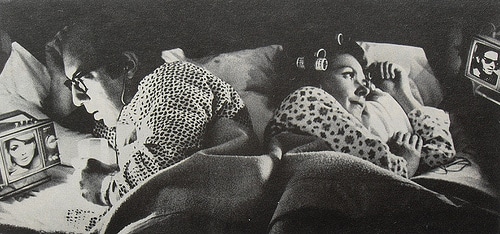
If you must use electronic devices in bed, be sure to use an app that filters out the blue light. Or don a pair of yellow-tinted safety glasses when watching TV!
10. Avoid blue light in the evening. In fact, dim all the lights. When the sun goes down, your body will naturally start releasing melatonin to help you get sleepy. Bright lights, specifically blue light, can disrupt that process, leaving you wide awake when it’s finally time to hit the hay. Increased exposure to blue light from our digital screens at nighttime is partly to blame for the increased sleeping problems modern humans are reporting. Ideally, you’d turn off all TV and computer screens two hours before bed to ensure optimum sleep. But we know most people can’t (or won’t) do that. Luckily, there are programs that you can install on your digital devices that eliminate the blue light emanating from your screen. Here are a couple that I’ve used:
- f.lux. As you get closer to nighttime, the blue light from the screen is reduced. It makes your screen look sort of orange at first, but then your eyes adjust so that it looks normal. Works across desktop operating systems.
- Twilight. This is an Android app that does the same thing as f.lux. It gradually eliminates the blue light from your smartphone and tablet screen as it gets closer to nighttime. I have it both on my HTC One and Samsung Tablet. (I’m not aware of any apps that do this on iOS. You can install f.lux on your iPhone or iPad, but you have to jailbreak it in order to do so.)
If you really want to ensure that you’re reducing and eliminating your exposure to blue light at nighttime, consider putting on a pair of yellow-tinted safety glasses at night. Yes, everything will look yellow and your wife will laugh at you, but it will help reduce your exposure to blue light from the TV while you’re watching Shark Tank, ensuring a better night’s sleep.
And be sure to dim the lights around the house too, so it’s not as bright as the noonday sun in your living room. Even regular white light can mess with your circadian rhythm.
11. Take a melatonin and/or ZMA supplement before bed. You can take melatonin supplements 30 minutes before going to bed to help you get to sleep faster. ZMA may also help in getting a deeper, more restorative sleep so you get those testosterone and human growth hormone-boosting benefits. I’ve had good success in combining these supplements, and taking a dose of both before hitting the hay.
12. Have a bedtime routine. A consistent bedtime routine can act as a cue to your body and mind to start getting sleepy. Shut off all the devices, put on your PJs (real men wear real pajamas), brush your teeth, and then read a paperback book or write in your journal until your eyes get really heavy.
Likewise, have a set morning routine that helps you get up and get going. Do some push-ups as soon as you get out of bed, plan out your week, have a good breakfast, and so on. Here are 6 things I often do to make my mornings something worth getting out of the covers for.
13. Take a James Bond shower one hour before bed. Here’s something you might consider adding to your bedtime routine: the James Bond shower. Research suggests that exposing yourself to fluctuating temperatures can speed up your body’s thermogenic effect, which can help you experience a deeper sleep. So one hour before bed, take a shower that starts out hot, and then ends with a few minutes of cold water.
In response to my video on cold shower benefits, folks have asked me how it can be true that cold showers both wake you up and help you get better sleep. This appears to be the answer – a strictly cold shower will invigorate you, while a hot-to-cold shower will induce sleepiness.
14. Avoid alcohol before bed. A nightcap might seem like just the thing to help you drift off to lala-land, but the quality of that sleep will be diminished. You’ll spend more time in Stages 1 and 2 of the sleep cycle and less time in the restorative Stages 3 and 4, and likely wake up feeling less than fully rested.
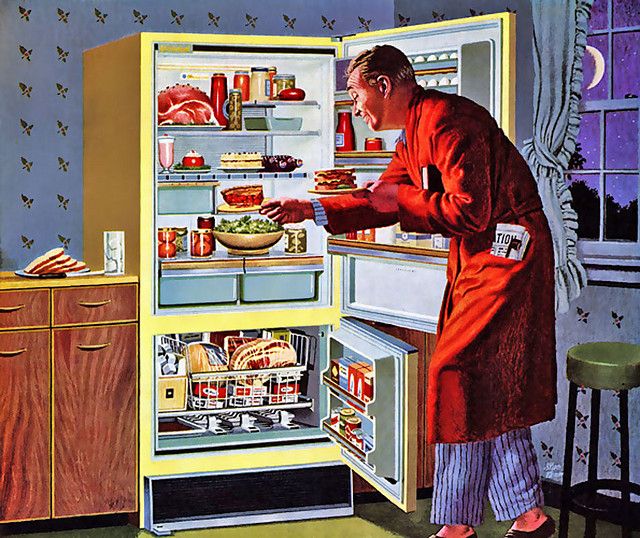
Eating something before bed can help you sleep soundly, but keep it to a light snack, rather than a full on meal. Pie OR sammy, buddy.
15. Have a midnight (or earlier!) snack. Scientists are just recently beginning to discover the connection between hunger/food and sleep. While studies point to differing reasons, most agree that a carby snack before you hit the hay may help you doze off quicker and stay asleep through the night. One study points to the insulin production of carb-laden foods as an aid in regulating our circadian rhythm. Another study notes that carby foods can increase the tryptophan in our blood, which induces sleep.
Either way, a snack of toast, whole grain crackers, a granola bar, a bowl of cereal, etc., could be exactly what you need for a night of restful slumber. Just make sure it’s not a full meal — don’t go more than 30g of carbs (a piece of whole-grain toast is about 12g, for frame of reference). Note that proteins, particularly meats, won’t help you sleep soundly as they’re harder to digest, and may interfere with tryptophan’s affect on your brain (which is why the idea that turkey alone causes sleepiness is a myth). A dab of peanut butter on toast, however, is just fine. (And might actually be ideal – PB contains a good dose of niacin which helps create calming, sleep-regulating serotonin.) There’s something to that old wives tale about a glass of warm milk before bed too – it contains tryptophan and calcium, which both help regulate the production of sleep-inducing melatonin.
A Note to Middle-of-the-Night Wakers
One of the most troubling sleep “disorders” is awakening in the middle of the night and not being able to go back to sleep. But this wasn’t always seen as a problem. In times past, people slept in a variety of schedules, sometimes slumbering for part of the night, waking up for a period, and then going back to sleep until the morning. They’d pad their total daily sleep totals with a nap or two during the day. Some argue that this kind of “polyphasic” sleep is quite natural, but was eradicated by the Industrial Revolution, which required everyone to get up for their jobs (and school) at the same time, and work the same universal shifts. The regimentation of school and work necessitated the normalizing of the consolidated 8-hour nighttime sleep schedule. Thus the idea that waking up in the middle of the night is a disorder has its roots not in biology, but in social and economic expectations.
That being said, the modern world is how it is. Unfortunately, very few of us can sleep in and take a nap every afternoon, and must rely on the convenience of the consolidated sleep schedule. Most have taken to this schedule well, but a few have not. If you’re among the ranks of the night wakers, don’t panic. Realize it can be quite normal, rather than a malady that needs to be handled with drugs. If you’d like to become a consolidated sleeper, try out the tips in this post. If you’d like to stick with polyphasic sleep, instead of stressfully tossing and turning during your nighttime wakenings, just embrace it. Get up and hang out until you get sleepy again, and then return to bed. If you can, schedule the start time for your classes or job later in the day so you can be more flexible with your wake time. Even if you can’t do that, try to get to bed earlier so that your total hours of sleep over the course of the whole night, including your wakeful period, adds up to a healthy 7-8 hours.
Getting To Sleep
16. If you can’t fall asleep within 20 minutes, get up. Sleep experts recommend that if you can’t fall asleep quickly — like in 20 minutes — that you should get up, go to another room, and read until you get sleepy. You don’t want to associate the anxiety and frustration of not being able to fall asleep with your bed. Keep your bed an oasis of calm, relaxing, restful feelings.
17. Keep things chilly. Your core body temperature decreases just a tad as you get deeper and deeper into sleep. This may explain why cooler room temps both help you get to sleep faster and contribute to a deeper sleep; you’re just getting that core temp down more quickly. Research has shown that the optimal room temperature for a good night’s rest is a surprisingly chilly 60-67 degrees Fahrenheit, so dial the thermostat down and turn on a fan when you hit the sack.
If you sleep with someone who likes things toasty, there are few things you can do to keep your side of the bed cool. On the cheap end is the Chillow. You fill it with water and place it on top of your pillow to give your noggin that “cooler than the other side of the pillow” feeling all night. I’ve used the Chillow with some success. Just watch out for leaks. For a more expensive, full-body option, check out the ChilliPad.
18. Make sure everything is pitch black in your bedroom. Even though your eyes are closed, light still has a way of getting to the ol’ retinas and disrupting your sleep. If you have trouble falling asleep and staying asleep, make sure your room is pitch black. Install blackout drapes so light from the outside can’t get into your room. Also, keep devices that have flashing lights and glowing screens away from your face.
19. Add white noise while you sleep. Some people simply sleep better when there’s the sound of a fan running or even radio static. That type of noise is called white noise. Why does it help us fall asleep? Well, one theory is that it simulates the sound environment that we were exposed to while in the womb. The more likely reason is that the white noise masks sudden noise changes that otherwise would have woken you up or startled your attention while you were drifting off to sleep. If you have trouble falling asleep, try adding some white noise at night. Turning on a fan often does the trick for most people. You can also invest in a bedside white noise maker that puts out sounds of static, heartbeats, or the soothing sound of falling rain.
20. Try progressive muscle relaxation. If you’re having trouble sleeping at night, instead of counting sheep, try progressive muscle relaxation. It calms the mind and releases tension in the muscles, leaving you feeling nice and relaxed. While lying down, start at your feet and tense and relax the muscles and tendons there. Just focus on the sensation of tensing and relaxing. Then move up to your calves, then to your thighs, and then quads, etc., etc. until you get up to your head.
21. Use the Nightwave Sleep Assistant. It’s a little device you put on your nightstand that projects a pulsing blue light on your ceiling. You sync up your breathing with the light pulse, and in a few minutes you’re drifting off to dreamland. I’ll bust this out every now and then when my mind is particularly racing, and I’m having a hard time falling to sleep.
22. Don’t take sleeping pills. Just like alcohol, sleeping pills (both over-the-counter and prescription) may help you get to sleep a bit faster, but they diminish the quality of your sleep. Not only do they cause you to spend more time in the less restorative stages of your sleep cycle, research suggests that you’ll only get, on average, 11 minutes more sleep with the pills than you would have without them. 11 extra minutes of crappier sleep, with the risk of grogginess and even more serious side effects? Usually not worth it.
Don’t turn to medications until you’ve tried everything else on this list – separately or together (the good night’s rest full-court press!). Here’s a checklist of the tips for you to experiment with, and mark off.
Check out our other resources on sleep:
______________
Sources:


